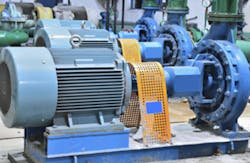(a.k.a. "The Pump Guy")
Hi Larry,
I just finished reading your article “Energy Matters” (Flow Control, July 2012, pages 14-20). In that article, you discuss the savings of operating a pump at 50,000 GPM as compared to 25,000 GPM. The calculations imply that the process doesn’t care at what rate the liquid is transferred; that is rarely the case. So, it seems that a variable speed pump is required so you can adjust the pump curve to match the ever-changing (dynamic) system curve.
Thanks and Best Regards,
John C.
Process Engineer
RELATED: Energy Matters–How efficient pumping systems can save the world
Hello John,
In that article, I manipulated and compared some data on a pump at 50,000 GPM and 25,000 GPM. Those two duty flows are arbitrary, but make the math simpler to manipulate.
I said many times in the same article that system alterations will drag the pump all over the curve. However, many common system alterations tend to drag the pump toward the left on the curve and restrict the flow. I’ll mention a few:
- Many process pumps fill a tank from the bottom. As the level rises in the destination vessel, the resistance increases on the pump. This drags the pump toward the left on the curve and reduces the flow.
- Many process pumps push liquids through filters. As the filter clogs, the resistance rises on the pump and flow is restricted.
- Water pipe tends to form scale and minerals on the pipe ID. A scaled pipe is like a pinched control valve. As the pipe internal diameter reduces, the resistance increases and the pump migrates to the left on the curve.
- Over time, new process devices (flowmeters, temperature probes, check valves, heat exchangers, etc.) are installed into existing pipe systems. The new devices increase the resistance on the pump. This reduces the flow.
For these and other reasons, instrumentation is critical on process pumps. The rate of flow certainly matters in a process plant.
The pump curve is a tool. A tool is an instrument or device that facilitates another function, purpose or task. Think of a wrench, TV remote control, or cell phone. A tool is useless when stored in a drawer.
The curve needs to be with, or close to the pump or the pump operator … not in a file in a drawer in a cabinet that remains mostly closed and locked.
Nowadays, more and more pumps are mated to variable-speed motors. A variable-speed motor (VSM) is another useful tool for the operator, but only when he knows how to use it. Consider your car.
An automobile is a variable-speed machine. The driver accelerates the car to the posted speed limit by coordinating his foot on the accelerator pedal with the speedometer gauge. Driving at the proper speed would be difficult or impossible without the speedometer. Likewise, the pump must have gauges or transducers (a flowmeter and differential-pressure indicators) for proper operation. Few process pumps have this.
The operator or shop mechanic is not authorized to purchase or install instrumentation onto the process equipment. Only the engineer can authorize the purchase and installation of gauges and flowmeters. So, if the engineer doesn’t order to install this necessary instrumentation, what does this say about the engineer? I mean, would you drive a car without a dashboard control panel? Would you buy a microwave oven without a touch pad and a timer?
The pump operator must interpret the pressure gauges and flowmeter with the pump curve and system curve. The system curve is another tool. Reality indicates no one has thought about the system curve since the design engineer reduced it to a little triangle, superimposed onto the pump curve when the pump was purchased.
Sadly, most equipment operators are only taught to manipulate the RPM of the variable-speed motor without regard to the consequences. The operators never learn how their manipulations will alter the pump’s performance within the system.
A VSM adjusts the pump’s performance up and down. The VSM is independent of the system. The VSM alters the pump’s performance (head and flow) without altering the system. Do the operators and engineers know this? Unfortunately, in most cases, probably not.
On the other hand, a control valve definitely alters the system. Manipulating the valve manipulates the system resistance. As the resistance changes, the pump’s performance is dragged to the left and right on the performance curve. Do the operators and engineers know this? Experience indicates, no.
A variable-speed pump is quite flexible and useful when the system curve is composed of mostly friction and velocity losses. In this type of system, the operator has flexibility to reduce or accelerate the pump speed within the system as production demands vary. Adjusting the speed to the demands of production allows the pump operator to conserve huge quantities of energy. Variable-speed motors are made for these systems.
A VSM is less flexible in a pump system with static head and pressure head. Depending on the system curve profile, the VSM might only be useful at 90 percent to 100 percent design speed. If the operator arbitrarily reduces the motor speed to 75 percent design or less, he’ll deadhead the pump against the system. But how will he know without the curve and gauges? He won’t know.
These applications make process and reliability engineers open the window and shout, “I HATE THESE VSMs!” These applications make your bearing and seal suppliers love you, as you finance their luxury cars and exotic vacations. These applications keep your vibration technicians working overtime. But who’s paying attention?
Regards,
Larry Bachus
Most process engineers studied chemistry in the university. Aside from lab equipment like table centrifuges for test tubes, automatic stirrers, and titration valves, chemistry majors have little exposure to mechanical equipment. On graduation, their employers assume these chemistry majors have an intimate understanding of process pumps and rotating machinery.
Come to the Oct. 1-3 Pump Guy Seminar in Philadelphia. We’ll bring you up to speed with simple language.
Larry Bachus, founder of pump services firm Bachus Company Inc., is a regular contributor to Flow Control magazine. He is a pump consultant, lecturer, and inventor based in Nashville, Tenn. Mr. Bachus is a retired member of ASME and lectures in both English and Spanish. He can be reached at [email protected].




